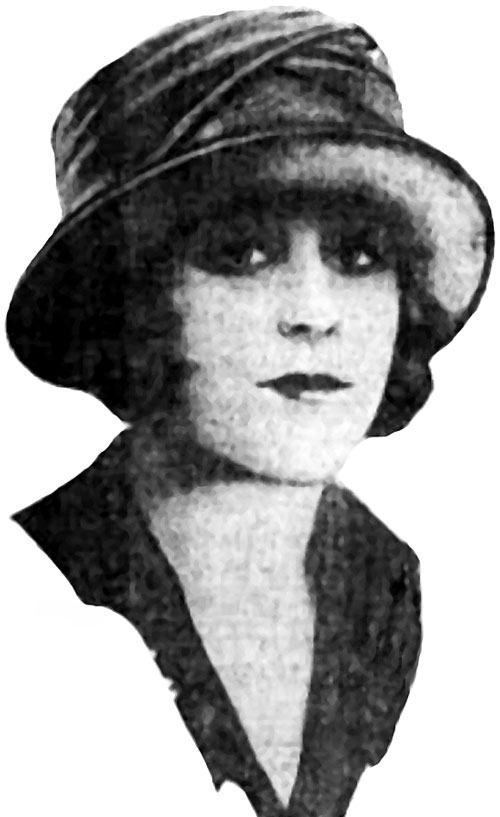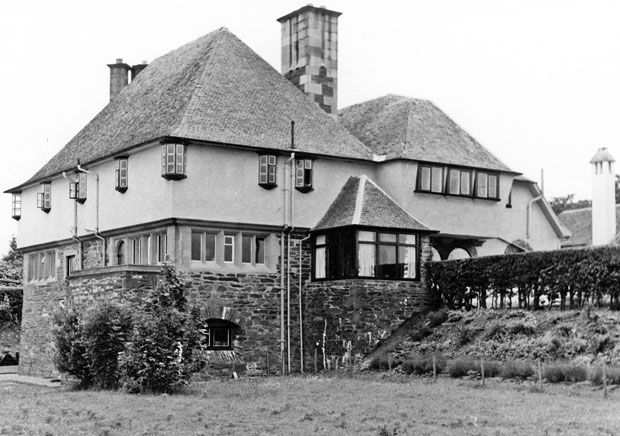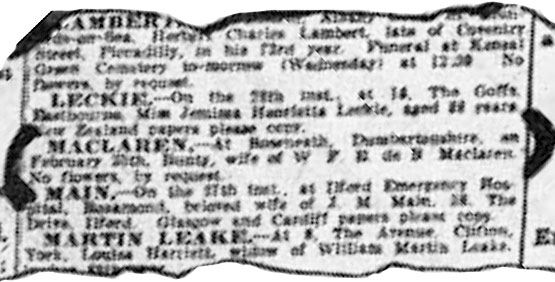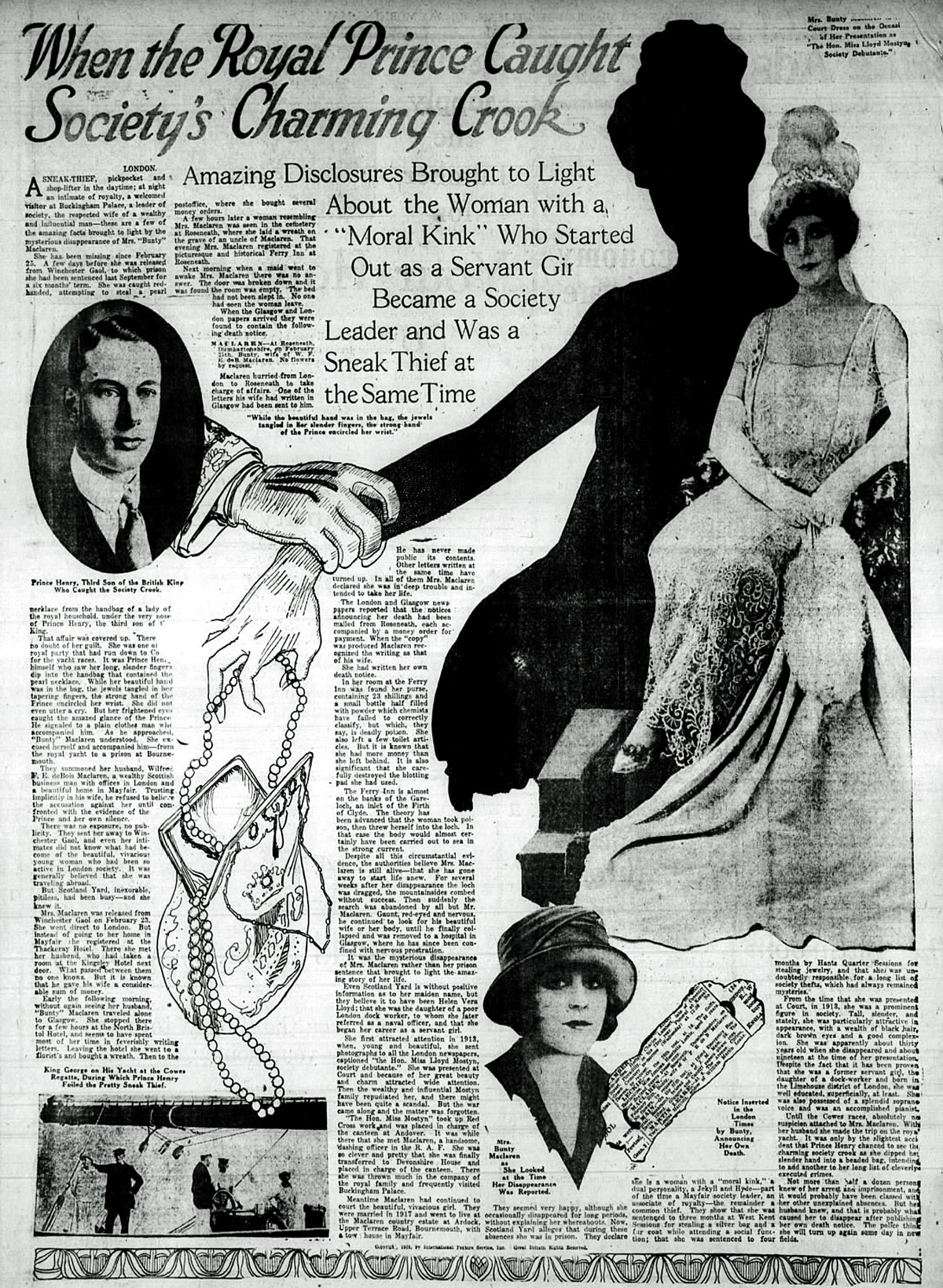ROSNEATH was the starting point of one of the most unusual stories ever of a person’s disappearance. It happened in 1924 — and was never solved.
Margaret Maclaren, wife of Wilfred F.E. de Bois Maclaren, was — to say the least — a colourful and controversial character.
 Her husband was the nephew of author, publisher, businessman and major benefactor of the Scouting movement, William Frederick de Bois Maclaren, of Armadale, Clynder.
Her husband was the nephew of author, publisher, businessman and major benefactor of the Scouting movement, William Frederick de Bois Maclaren, of Armadale, Clynder.
William bought and presented the Gilwell Park estate near the Epping Forest to his friend Robert Baden-Powell, founder and first Chief Scout of the Boy Scouts Association, for use as a scouting centre.
That happened in 1919, and five years later the drama of Mrs Maclaren unfolded.
The Helensburgh and Gareloch Times reported that she arrived at Rosneath by the noon boat on a Monday.
Instead, however, of proceeding to Armadale, she booked a room at the Ferry Inn (below right), stating that she would probably be staying there until the Friday, when she expected her husband to arrive.
Her luggage, which consisted of a square cardboard hat box and one small bag, bore the labels of a London hotel.
After checking in, Mrs Maclaren, known as Bunty, took a short walk and it is thought that she placed a wreath on the grave of her husband’s uncle who died on June 3 1921.
She had lunch about 1pm, wrote a number of letters during the afternoon, and called at the Rosneath Post Office where she purchased two postal orders — one for 4 shillings and the other for 7 shillings.
 In the evening she said that she felt very tired, and she retired to bed early. Before going she requested that she should not be called in the morning, and she asked for breakfast at 9am.
In the evening she said that she felt very tired, and she retired to bed early. Before going she requested that she should not be called in the morning, and she asked for breakfast at 9am.
Mrs Maclaren’s instructions were followed, and it was not until 10am that her room was entered and found to be empty. The main door of the hotel was found open at 6am.
The paper reported that no evidence was found in her room which would lead to any definite theory as to what had become of the missing lady.
Her luggage, said to be brand new, a purse containing some money, and one or two articles of clothing were found.
After some time had been allowed to elapse, relatives and the police were informed. The matter did not become public for several days.
What added to the mystery of the disappearance was that in the ‘Weekly Scotsman’ of March 1 there appeared the following death notice:
“MACLAREN. — At Rosneath, Dumbartonshire, on February 25th, Bunty, wife of W.F.E.de B Maclaren. No flowers by special request.”
 However the death notice was not inserted by Mr Maclaren or any other member of the family.
However the death notice was not inserted by Mr Maclaren or any other member of the family.
During the early part of the week search parties scoured the Rosneath roads and hillside, and on the Saturday Rosneath Bay was dragged.
But the search was discontinued on the Sunday, and no further local searches took place.
The Times article then moved on to speculate: “In reviewing the happenings of the week, one is struck by the reticence of the police and the general difficulty experienced in getting at the facts.
“The main question is, of course — is Mrs Maclaren alive or dead? The only available clue in this connection is the mysterious death notice which appeared in the ‘Weekly Scotsman’.
“The statement that it was not inserted by Mr Maclaren or any other member of the family has not been denied, and therefore the only conclusion can be that it is the work, either of someone outside the known figures in the case, or of Mrs Maclaren.
“If it was inserted by an outsider, the affair assumes a still more complex nature, but if by Mrs Maclaren, then there is a touch of irony in the whole thing, especially in that ‘No flowers by special request’.
“The date in the death notice is given as Monday 25th. The hotel was closed at 10pm on that Monday night, and Mrs Maclaren, had she had any thoughts of suicide, would have allowed more than two hours to elapse before committing the act.
“This discrepancy between the date in the notice and the date of disappearance would appear to point to some solution other than that of suicide. It may be many years before the final chapter of this story is written.
“It is again improbable that a person intending to take her life would travel from London to Rosneath, eat a good dinner, order a hot bath, get into bed, and afterwards arise in the middle of the night, dress and go out into the February darkness to plunge into icy water.
“Police attention seems also to have turned towards inquiries outside the Gareloch district, a development which implies a sense of the possibility that Mrs Maclaren may be safe.
“They have, it is understood, opened communication with various parts of the country, in the hope that the mystery may be elucidated by the finding of the woman alive and well.
“That is regarded more than ever as a promising line of inquiry.
“It transpires that parties occupying a house near the road at Garelochhead heard light, hurrying footsteps on the road between four and five o’clock on the morning that Mrs Maclaren disappeared.
“She may have walked, it is now pointed out, all the way to Helensburgh, a distance of about 15 miles, in which event her departure from the district might easily escape particular observation when accomplished at such an early hour.”
A report in the ‘Glasgow Evening News’ then added new dimensions and questions to the mystery.
“Is it possible,” the paper asked, “that Mrs Bunty Maclaren is the same woman as Mrs Helen Vera Maclaren, sentenced to six months imprisonment at Bournemouth for shoplifting in September last and released from Winchester jail a few days earlier?
“London newspapers of Tuesday morning appear to be convinced that there is no doubt about the women being identical, yet the question of ages may well occasion some dubiety.
“The woman sentenced at Bournemouth had a long previous career of crime, beginning in 1901. Mrs W.F.E.de B.Maclaren, the Gareloch woman, has all along been described as little over 30 years of age.
“When the Bournemouth case was tried, the culprit’s previous convictions were brought up. The police stated that she was bound over for stealing in Greenwich in 1901, and again, five years later, at Westminster.
“Her first term of imprisonment was at the West Kent Sessions, when she received three months on charges of stealing jewellery. At Hants Quarter Sessions she was given twelve months for stealing jewellery from the Isle of Wight at the very time she had the entrée to exclusive clubs there.
“Mr Maclaren, it is stated, met his wife at Andover whilst she was running a war canteen there and he was stationed at the RAF camp.
“Last year they were living at Ardock, Upper Terrace Road, Bournemouth, when the woman was arrested and charged with stealing a silver bag and a fur coat, as well as clothing. She pleaded guilty
“It was stated that the husband was in complete ignorance of his wife’s past as well as of her habit of stealing.
“She was described to the Bournemouth court by her counsel as a woman with a ‘moral kink’. She has been described as a psychological mystery, as a woman liable to act on irrational impulses, and for whose actions there could be no accounting.
“In 1913 her photograph, purporting to be that of ‘The Hon. Miss Lloyd Mostyn’, who was among the debutants presented at the first Court of the year, was published, but the family repudiated her and declared she had no right to use the name.
“During the war the woman’s better self asserted itself. From managing a war canteen at Andover she rose to be commandant at the Red Cross depot at Devonshire House.
“Charming and well educated, she was immensely popular, and her assistance was widely sought.
“When released from Winchester last Saturday week she seems to have gone straight to London, where she stayed at the Thackeray Hotel.
“Next door, at the Kingsley Hotel, her husband was staying. He saw her and gave her money, but did not join her, and she travelled to Glasgow by the overnight train, probably without his knowledge.
“Stopping for a few hours at the North British Hotel, she wrote some letters — one to her cousin, in which she complained of feeling unwell, and said that if she felt no better she would call in a doctor.
“At Glasgow she bought a wreath, and, proceeding to Rosneath, on Monday morning laid it on the grave of her husband’s uncle.”
The ’Evening News’ reported that Mr Maclaren, the husband of the missing woman, was staying at Armadale, the residence of his aunt, Mrs A.J.Maclaren, whose dead husband left his nephew, Wilfred and his elder brother Charles, as well as their sister, with sufficient means to allow them to live leisurely lives.
He was educated at Larchfield and in England, and for some time worked with a well-known Glasgow firm, gaining an insight into business methods. He then took a trip around the world, and on his return joined his uncle’s firm, Maclaren & Son Ltd., merchants, in Shoe Lane, London.
It was stated that Wilfred McLaren met his wife while he was an officer in the Flying Corps, and they were married in London towards the end of the war.
The paper added: “The people at Rosneath know little about them, beyond that they stayed at intervals at the aunt’s residence, and at times paid short visits when the family were away from Armadale.
“Mrs Maclaren is spoken of as being a very pleasant young Englishwoman who made friends quickly.”
While no-one to this day knows what happened to her, much more information could be found in papers published abroad.
The May 13 1924 edition of the Western Argus in Western Australia headlined the story “A missing wife mystery’.
Here is their report:
“What is the mystery behind the disappearance during the night of the wealthy wife Mrs de Bois Maclaren, whose death notice was inserted by some person unknown a few days after she vanished from an hotel?
“The strange disappearance (says the Roseneath correspondent of the London ‘Sunday Express’) has all the elements of an Edgar Allan Poe story.
“Did Mrs Maclaren insert the death announcement herself? Is she still alive and in hiding for some inexplicable reason?
“Local residents are asking these questions while a hunt is being made for the missing woman. The husband, Mr Wilfred F. E. de Bois Maclaren, has hurried from London to join in the search.
“The loch near the hotel where she was last seen is being dragged, but so far without result.
“Mrs Maclaren arrived at Roseneath about noon by steamer from Craigendoran. A surprising fact, is that, although the house of her husband’s aunt is only about a mile from Roseneath pier, Mrs Maclaren did not visit her.
“After lunch Mrs Maclaren spent several hours in the sitting room she engaged at the hotel where she wrote several letters.
“She is understood to have gone out later in the afternoon to post these letters. If they were posted they may throw some light upon the mystery.
“When on the Tuesday morning the maid failed to get a response to her knocking at the bedroom door no anxiety was immediately felt, for it was believed that Mrs Maclaren had risen early and gone for a walk along the loch side.
“At 10 o’clock, however, the proprietor asked the maid to enter the room, which was empty. The luggage which, with Mrs Maclaren’s purse remained in the room, was new and had upon it labels from a London hotel.
“Information was given to the police, and a telegram was sent to Mr Maclaren in London. Then appeared the mysterious death announcement in an Edinburgh weekly newspaper.
“It read: ‘Maclaren —At Roseneath, Dumbartonshire, on February 25, Bunty, wife of W. F. E. deB. Maclaren. No flowers, by special request.’
“The paper goes to press on Wednesday about 5 o’clock. The notice was posted on the previous Monday, the day Mrs. Maclaren disappeared. It had a covering letter and a postal order in payment. The newspaper proprietors have preserved the letter and the signature.
“When the police are called in, if they should be called, the contents of the letter will be disclosed. The selection of an east of Scotland newspaper was unusual, since the relatives of the missing woman stay at Garelochside.
“When she arrived on the Monday Mrs Maclaren, the hotelkeeper says, appeared to be in good health and spirits.
“Her family have taken possession of the room the vanished lady occupied. Everything in it has been left undisturbed, and the key has been given to the police.
“Nobody in the district saw Mrs Maclaren on the Tuesday morning, which suggests that it was still dark when she left the hotel.
“It was thought that she might have walked from Roseneath to Gareloch Head and boarded a steamer there at 7.25 am. The lady was known to the purser of the steamer, and he has reported that he did not see her.
“It is unlikely that Scotland Yard’s assistance will be invoked in the matter.”
The Advertiser in Adelaide reported: “It is now almost definitely established that Mrs Maclaren sent her own death notice to the newspapers. Her friends believe she is indulging in another freak escapade.”
Typically, perhaps, the spiciest aspects of the story appeared in an American newspaper, the Springfield News-Leader, based in Missouri, on May 11.

It did not pussy-foot about. This intro on the story of Mrs Maclaren’s past called her a thief.
It read: “She was caught red-handed attempting to steal a pearl necklace from the handbag of a lady of the royal household, under the nose of Prince Henry, the third son of the King.
“The affair was covered up. There was no doubt of her guilt.”
The paper claimed that she was one of the royal party who had run down to Cowes for the yacht races. It was Prince Henry himself who saw her long slender fingers dip into the handbag containing the pearl necklace.
The report continued: “While her beautiful hand was in the bag, the jewels tangled in her tapering fingers, the strong hand of the Prince encircled her wrist. She did not even utter a cry.
“But her frightened eyes caught the amazed glance of the Prince. He signalled to a plain-clothes man who accompanied him. As he approached, Bunty Maclaren understood. She excused herself and accompanied him — from the royal yacht to a prison in Bournemouth.
“They summoned her husband, Wilfred F.E. de Bois Maclaren, a wealthy Scottish businessman with offices in London and a beautiful home in Mayfair.
“Trusting implicitly in his wife, he refused to believe the accusation against her until confronted with the evidence of the Prince and her own silence. There was no exposure, no publicity.
“They sent here away to Winchester Gaol, and even her intimates did not know what had become of the beautiful, vivacious young woman who had been so active in London society. It was generally believed that she was travelling abroad.”
The News-Leader discovered that one of her letters went to her husband, but he never made its content public. In all of the letters Mrs Maclaren declared she was in deep trouble and intended to take her life.
The report went on:“The theory has been advanced that the woman took poison, then threw herself into the loch.
“In that case the body would almost certainly have been carried out to sea by the strong current.
“Despite all the circumstantial evidence, the authorities believe Mrs Maclaren is still alive — that she has gone away to start life anew.
“For several weeks after her disappearance the loch was dragged and the hillsides combed without success.
“Then suddenly the search was abandoned by all but Mr Maclaren.
“Gaunt, red-eyed and nervous, he continued to look for his beautiful wife or her body until he finally collapsed and was removed to hospital in Glasgow, where he has since been confined with nervous prostration.
“It was the mysterious disappearance of Mrs Maclaren rather than her prison sentence that brought to light the amazing story of her life.
“Even Scotland Yard is without positive information as to her maiden name, but they believe it to have been Helen Vera Lloyd; that she was the daughter of a poor London dock worker, to whom she later referred as a naval officer; and that she began her career as a servant girl.
“She first attracted attention in 1913 when, young and beautiful, she sent photographs to all the London newspapers, captioned ‘the hon Miss Lloyd Mostyn, society debutante’. She was presented at Court and because of her great beauty and charm attracted wide attention.
“Then the wealthy and influential Mostyn family repudiated her, and there might have been quite a scandal. But the war came along and the matter was forgotten.
“At Devonshire House she was often in the company of the royal family and frequently visited Buckingham Palace. She married Maclaren in 1917.
“They seemed very happy, although she occasionally disappeared for long periods without explaining her whereabouts. Now Scotland Yard alleges that during these absences she was in prison.
“They declare she is a woman with a ‘moral kink’, a dual personality, a Jekyll and Hyde — part of the time a Mayfair society leader, the remainder a common thief.
“They think she was responsible for a long list of society thefts which had always rmained unsolved.
“From the time she was presented in court in 1913 she was a prominent figure in society.
“Tall, slender and stately, she was particularly attractive in appearance, with a wealth of black hair, dark brown eyes and a good complexion. She was apparently about 30 years-old when she disappeared and 19 at the time of her presentation.
“Despite the fact that it has been proven that she was a former servant girl, the daughter of a dock worker and born in Limehouse, London, she was well educated, superficially at least.
“She was also possessed of a splendid soprano voice and was an accomplished pianist.”
The paper said that police thought she would turn up again someday in new fields.
They summed her up as: “A sneak thief, pickpocket and shop-lifter in the daytime; at night an intimate of royalty, a welcomed visitor at Buckingham Palace, a leader of society, the respected wife of a wealthy and influential man.”
No subsequent mentions have been found of this extraordinary unsolved mystery at home and abroad.





